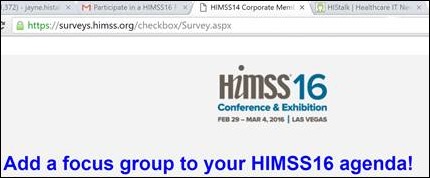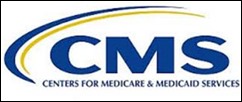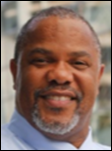News 2/12/16
Top News
CommonWell Health Alliance announces new members EClinicalWorks, HIMSS, ImageTrend, LifeImage, Mana Health, MediPortal, and Modernizing Medicine. I’m not clear why HIMSS joined or how some of its own high-paying members who haven’t joined CommonWell (like Epic) will feel about its implicit endorsement.
Reader Comments

From Skinny Little B-Word: “Re: Grey Bruce Health Services in Canada. CIO Rob Croft and Manager Peggy Millar are gone.” Unverified. There’s nothing new on their LinkedIn or on Grey Bruce’s executive page.
From Dy-No-Mite: “Re: Mr. H. I don’t understand that name.” I needed an anonymous email address when I first started writing HIStalk in 2003 since my employer at that time was threatening me for writing ill of a vendor who richly deserved it (we were their customer, although I wasn’t writing anything I had learned from that experience). My creativity was limited, as it often is, so I chose mr_histalk@yahoo.com, attaching no particular significance to it. Readers started calling me Mr. HIStalk and that got shortened to Mr. H over the years. I never call myself “Mr.” anything in real life, so the reference was really more like someone who is privately dubbed “Mr. Happy Meal” for frequenting McDonald’s or “Mr. Upbeat” for exuding perpetual grumpiness.
From Identity Thief: “Re: FL Senate bill 1299. It says hospitals must confirm Medicaid patient identities using both biometrics and a positive match with the DMV’s database. Does that mean beneficiaries must have a driver’s license? I also don’t see where funds have been set aside to cover the cost.” The idea probably taps into annoyance taxpayers feel for those who take advantage of Medicaid, a situation that bugs me as well, but medical and insurance fraud isn’t limited to Medicaid patients. Biometrics aren’t perfect and pose security risks of their own (the “stolen electronic fingerprint” scenario) and I don’t get the DMV connection, which must require Medicaid patients who don’t drive to obtain a Florida DMV-issued state ID card. I’m sure this will raise some red-faced debate among people with strong opinions about illegal immigrants and discrimination. It’s a nice idea to positively ID patients for even better reasons (like patient safety) but our lack of political will for something as simple as a national patient identifier makes it unlikely that this bill will withstand the inevitable legal challenges even if it beats the odds of getting that far.
From Bernie: “Re: Jonathan Bush. It’s ironic that Bush talks down Epic. Try being a vendor that wants to integrate with Athena. They make it very difficult, even when there is customer demand. Bush is no knight in shining armor and their MDP program is a sham.” Unverified.
HIStalk Announcements and Requests


We funded the DonorsChoose grant request from Mrs. Heinrich from California, who asked for headphones, lapboards, privacy petitions, paper, and glue.


Also checking in was Mrs. Sutton from Illinois, who says her fourth grade students had been making their own fraction strips from paper and colored pencils before receiving the 25 sets of fraction, decimal, and percent tiles we provided. She’s now having the students teach fraction concepts to second graders to “encourage my fourth grade students to be peer leaders as well as master fraction builders.”
Listening: new from Nothing But Thieves, hard-rocking Brit pop that sounds a bit like Muse with guitars instead of keyboards. They’re on a US tour now with upcoming stops in the southern US, including gigs at legendary clubs like Cat’s Cradle, 40 Watt Club, even the Orlando House of Blues where we had HIStalkapalooza not long ago. It’s a refreshing blast of melodic rock surrounded by a sea of formulaic hip-hop, emotive singer-songwriter warblings, and heavily technically augmented songs better suited for dancing than listening.
This week on HIStalk Practice: Some physicians didn’t get the memo about ICD-10. Washington State Medical Association Executive Director and CEO Jennifer Hanscom shares the successes – and frustrations – members have had with health IT. First Stop Health raises $2.1 million. HIEs invest in new patient-matching technology, plus there’s FINALLY a way to summon your Tesla from your Apple Watch. Navicure CEO Jim Denny advises physicians to use ICD-10 momentum to meet 2016 revenue cycle goals. The California Health Care Foundation highlights digital health technologies making a difference in safety net populations. Escape from paperwork and Big Brother become big drivers of direct care.
This week on HIStalk Connect: Concierge provider group One Medical acquires digital health startup Rise for $20 million. Researchers in the UK are approved to study human embryo genome editing. With a variety of virtual reality devices scheduled to arrive on the market in 2016, VR fitness applications begin to emerge. Withings unveils a new blood pressure tracking feature that it will sell as an in-app purchase to its users. 23andMe partners with fertility startup Celmatix to develop precision medicine fertility treatments and infertility tests.
HIStalkapalooza
I created this page so you can check to see if you should have received an emailed HIStalkapalooza invitation but didn’t because of spam filters. My interest in doing so is self-serving since I’m getting an absurd number of party-related emails that I really don’t have the time to mess with. Please don’t email me or Lorre if you weren’t invited or you’ve decided you want to bring a guest you didn’t previously register – we aren’t inviting anyone else and there’s no wait list. Every year otherwise smart people express righteous indignation that we didn’t invite them even though they didn’t even bother to sign up, apparently relying on our staff psychic to detect their interest (and email address).

Use Twitter hashtag #HIStalkapalooza if you want to get fired up pre-party in the remaining couple of weeks.
Webinars
February 17 (Wednesday) noon ET. “Take Me To Your Leader: Catholic Health Initiatives on Executive Buy-In for Enterprise Analytics.” Sponsored by Premier. Presenters: Jim Reichert, MD, PhD, VP of analytics, Catholic Health Initiatives; Rush Shah, product manager analytics factory, Premier. Catholic Health Initiatives, the nation’s second-largest non-profit health system, knew that in order to build an enterprise analytics strategy, they needed a vision, prioritization, and most importantly buy-in from their executives. Dr. Jim Reichert will walk through their approach.
February 23 (Tuesday) 1:00 ET. “Completing your EMR with a Medical Image Sharing Strategy.” Sponsored by LifeImage. Presenters: Don K. Dennison, consultant; Jim Forrester, director of imaging informatics, UR Medicine. Care coordination can suffer without an effective, cost-efficient way to share images across provider networks. Consolidating image management systems into a single platform such as VNA or PACS doesn’t address the need to exchange images with external organizations. This webinar will address incorporating the right image sharing methods into your health IT strategy.
Acquisitions, Funding, Business, and Stock
Wipro will acquire Tampa-based insurance company BPO and exchange services vendor HealthPlan Services for $460 million in cash.

The founder of Pristine, which initially offered a healthcare Google Glass app and then changed business models at some point into visual collaboration for field inspectors, sues an Austin-based venture capital firm for stealing his business. Kyle Samani’s suit claims the real goal of S3 Ventures LLC is “to invest in newly formed companies in order to ultimately take the companies from their founders just as the company becomes successful.” He alleges that Pristine, which raised $6.2 million but has not received funding since September 2014, sold 700,000 of his unvested shares. The real lesson learned might be to avoid creating an enterprise-focused business whose platform is a beta-status consumer gadget.
Sales
Health Partners New England chooses Medsphere’s OpenVista EHR.
Cormac contracts with Premier to provide a cloud-based registry to support CMS’s Oncology Care Model.
The American College of Radiology and the University of Florida choose the Visage 7 Enterprise Imaging Platform as enterprise diagnostic viewer for training diagnostic radiology residents.
Announcements and Implementations
McKesson partners with HealthQX, which offers a claims analysis system, to offer software to help payers design and run bundled payment programs.
Bottomline Technologies announces that its Healthcare Privacy and Data Security solution learns normal user behavior and reports exceptions.
First Databank releases OrderKnowledge Canada, a pre-built CPOE drug knowledge base.
A tiny study finds that use of Glytec’s Glucommander IV glycemic control system reduced diabetic ketoacidosis admissions by 45 percent.
Government and Politics
The President’s $4.1 trillion budget, already rejected by Congress, would have boosted ONC’s budget by $22 million for interoperability work. HHS would have received a mind-boggling $1.14 trillion, up 11 percent since 2015, also increasing its FTE headcount to nearly 80,000.
Privacy and Security
The CPA firm of a Nebraska hospital warns it that a laptop stolen from one of its employees had encryption software installed that wasn’t working, exposing the information of 4,200 of the hospital’s patients.
Magazine publisher Time Inc. buys the faded Internet star MySpace to get data on its 1 billion registered users, with Time’s CEO saying the deal “is all about the marriage of first-party data and premium content.” The seller was Viant, which has gone through three names since it bought Myspace in 2011 for $35 million with Justin Timberlake as a partner, hoping to make it a music hub.
Insurance company Centene says it found the six PHI-containing hard drives it reported losing a few weeks ago. They had been placed in a locked storage box awaiting destruction. It’s puzzling why they wouldn’t have looked there first, or why their employee wouldn’t have logged them as being held for disposal. I would bet at least one person will be fired because of the embarrassment caused and cost expended.
Innovation and Research
An AHRQ-funded study finds that higher levels of hospital EHR usage is associated with a lower rate of adverse events for patients with cardiovascular disease, pneumonia, or conditions requiring surgery.
Other
US News withdraws its Best Children’s Hospitals specialty rankings for two hospitals that had submitted erroneous survey data, adding that it “will implement additional data integrity processes to help identify potentially inaccurate data prior to publication.”
University of North Carolina Health Care signs a partnership agreement with Mercy in which Mercy Virtual Care Center will monitor patients in a 28-bed UNCHC ICU.
The Chicago Tribune proudly describes its collaboration with scientists to mine data from the FDA’s adverse event reporting system and Columbia University Medical Center’s EHR to find four new drug-drug interactions that can prolong cardiac QT interval and potentially cause arrhythmias. Thank goodness the actual journal article is concise and factual rather than a crappy Trib attempt at long-form journalism, meaning it’s do long and hammily dramatic that you just want to wring the writer’s neck to make them get to the point. Obviously the study found apparent correlation with one hospital’s information – the real work now begins in proving causation, a challenging project that drug companies aren’t likely to underwrite since the result could reduce sales.
ZDoggMD might be venturing into Weird Al territory with a never-ending barrage of parody videos that threaten overexposure, but here’s his latest that lab people will enjoy, “In Da Lab.” Watch for the Theranos reference. Pop red tops, homeys.
Sponsor Updates
- Marketing firm Image.works will offer its healthcare clients CRM capabilities from Influence health.
- Rep. Bob Dold (R-IL) visits Intelligent Medical Objects to learn about IMO Terminology.
- The local paper covers LifeImage’s acquisition of Mammosphere.
- Netsmart will exhibit at the MHCA Winter Conference and Annual Meeting February 16 in Clearwater Beach, FL.
- EClinicalWorks releases a new podcast, “What’s Ahead for 2016.”
- Healthfinch co-founder Lyle Berkowitz, MD keynotes the AMA/MGMA Collaborate in Practice Conference March 20-22 in Colorado Springs, CO.
- Park Place International’s Erick Marshall is named a VMware 2016 Vexpert.
Blog Posts
- “New” Words to Watch for in 2016 (ID Experts)
- The EHR Developer Code of Conduct – Next Steps in its Evolution (Impact Advisors)
- Top 5 Reasons I Love HIMSS! (Ingenious Med)
- FHIRside Chat: Two Doctors See New Future Enabled by FHIR, Part 1 (InterSystems)
- Internet of Things and Healthcare (Medecision)
- Precision Medicine and You (Orion Health)
- MACRA 101: Wrapping Our Heads around MU, MACRA, MIPS, and More … (Divurgent)
- Who’s Next? The 3 Ms of HIPAA Compliance Audits (Hayes Management Consulting)
- EHR System Selection – 7 Tips for Transforming Clinical Care (The HCI Group)
- Embracing New Media and Online Resources to Enhance Patient Engagement (Healthwise)
- 2016 – The Year of the Bot (Recondo Technology)
- 3 Major Ways mHealth Apps Improve Hospital HCAHPS Scores (PracticeUnite)
- 3 key learnings from implementing a care team collaboration platform (PerfectServe)
- The making of a vision … of the future of obstetrics (PeriGen)
- Information Management Part 3 – The Information Ecosystem (ClinicalArchitecture)
- PMD by the Numbers (PMD)
- 4 Common Risks for Reporting and Analytics in the Midst of Rapid Expansion (Sagacious Consultants)
- Join us at the HIMSS Interoperability Showcase (Stella Technology)
- The Next Wave of Patient Self Scheduling (Streamline Health)
Contacts
Mr. H, Lorre, Jennifer, Dr. Jayne, Lt. Dan.
More news: HIStalk Practice, HIStalk Connect.
Get HIStalk updates.
Send news or rumors.
Contact us.





























































































Re: Dr Z. Great story, but whatever happened to professional courtesy???